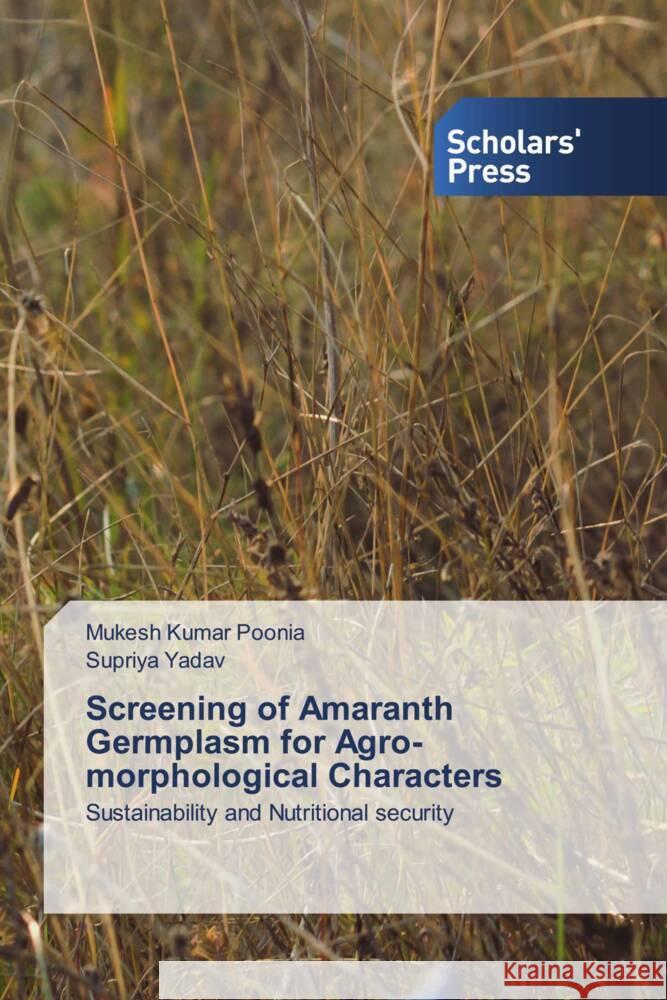topmenu
Wyniki wyszukiwania:
wyszukanych pozycji: 9
 |
Slumber Serenades: Bedtime Stories with Morning Miracles
ISBN: 9798859703036 / Angielski / Miękka / 2023 / 300 str. Termin realizacji zamówienia: ok. 16-18 dni roboczych (Dostawa w 2026 r.) |
cena:
303,90 |
 |
Screening of Amaranth Germplasm for Agro-morphological Characters
ISBN: 9786206769606 / Angielski / Miękka / 116 str. Termin realizacji zamówienia: ok. 10-14 dni roboczych (Dostawa w 2026 r.) Amaranth is a pseudocereal, cultivated over a wide range of agro-climatic conditions with temperature range of 20 - 40°C, elevation 500-2500 meter above mean sea level and rainfall between 800 mm to 1500 mm. Amaranthus comprises 70 species of C4 dicotyledonous herb out of which 18 species are available in India and being C4 plants suitable to survive and flourish under adverse climatic conditions. Amaranth is an excellent source of iron and beta-Carotene and can help in alleviating iron and vitamin A deficiencies. Proteins from amaranth have better balanced amino acid compositions and higher...
Amaranth is a pseudocereal, cultivated over a wide range of agro-climatic conditions with temperature range of 20 - 40°C, elevation 500-2500 meter ab...
|
cena:
294,77 |
 |
Auto-medicação e práticas de armazenamento de medicamentos
ISBN: 9786208564322 / Portugalski / Miękka / 2025 / 60 str. Termin realizacji zamówienia: ok. 16-18 dni roboczych (Dostawa w 2026 r.) |
cena:
191,57 |
 |
Selbstmedikation und Lagerung von Medikamenten
ISBN: 9786208564254 / Niemiecki / Miękka / 2025 / 64 str. Termin realizacji zamówienia: ok. 16-18 dni roboczych (Dostawa w 2026 r.) Die hohe Prävalenz chronischer Krankheiten und die leichte Verfügbarkeit von rezeptfreien Medikamenten haben den Konsum von verschriebenen Medikamenten und die Selbstmedikation unter Bedürftigen begünstigt. Ebenso wichtig ist es, dass nicht nur die Patienten, sondern jeder Einzelne die Anforderungen an eine angemessene Lagerung kennt, um negative gesundheitliche und wirtschaftliche Folgen zu vermeiden. In einer Querschnittsstudie wurden die Praktiken der Selbstmedikation und der Arzneimittellagerung unter Pharmaziestudenten in Banasthali Vidyapith, Rajasthan, untersucht. Zur Datenerhebung...
Die hohe Prävalenz chronischer Krankheiten und die leichte Verfügbarkeit von rezeptfreien Medikamenten haben den Konsum von verschriebenen Medikamen...
|
cena:
191,57 |
 |
Samoleczenie i praktyki przechowywania leków
ISBN: 9786208564315 / Polski / Miękka / 2025 / 60 str. Termin realizacji zamówienia: ok. 16-18 dni roboczych (Dostawa w 2026 r.) |
cena:
191,57 |
 |
Pratiques d'automédication et de stockage des médicaments
ISBN: 9786208564285 / Francuski / Miękka / 2025 / 64 str. Termin realizacji zamówienia: ok. 16-18 dni roboczych (Dostawa w 2026 r.) La forte prévalence des maladies chroniques et la facilité d'accès aux médicaments en vente libre ont favorisé la consommation de médicaments prescrits et d'automédication chez les personnes démunies. Il est tout aussi important de veiller à ce que non seulement les patients, mais aussi tout le monde, soient conscients des exigences de stockage appropriées afin de prévenir les conséquences négatives sur la santé et l'économie. Une étude transversale a été menée pour évaluer les pratiques d'automédication et de stockage des médicaments parmi les étudiants en pharmacie de...
La forte prévalence des maladies chroniques et la facilité d'accès aux médicaments en vente libre ont favorisé la consommation de médicaments pr...
|
cena:
191,57 |
 |
SELF-MEDICATION AND DRUG STORAGE PRACTICES
ISBN: 9786200286185 / Angielski / Miękka / 2024 / 56 str. Termin realizacji zamówienia: ok. 16-18 dni roboczych (Dostawa w 2026 r.) The high prevalence of chronic diseases and ease of availability of over-the-counter medications have favored both prescribed and self-medication consumption among the needy. It's equally important to ensure that not only patients but everyone should be aware of appropriate storage requirements to prevent negative health and economic consequences. A cross-sectional study to evaluate self-medication and drug storage practices among pharmacy students at Banasthali Vidyapith, Rajasthan, was considered. A semi-structured, validated questionnaire with 21 open and closed-ended questions addressing...
The high prevalence of chronic diseases and ease of availability of over-the-counter medications have favored both prescribed and self-medication cons...
|
cena:
195,83 |
 |
Automedicazione e pratiche di conservazione dei farmaci
ISBN: 9786208564308 / Włoski / Miękka / 2025 / 56 str. Termin realizacji zamówienia: ok. 16-18 dni roboczych (Dostawa w 2026 r.) |
cena:
191,57 |
 |
Agricultural Finance & Cooperation
ISBN: 9789358870848 / Angielski / Twarda / 2023 / 156 str. Termin realizacji zamówienia: ok. 30 dni roboczych (Dostawa w 2026 r.) Agricultural Finance & Cooperation is an essential textbook that covers the complexities of contemporary agriculture by focusing on financial principles, fund procurement, and efficient utilization of funds, as well as cooperative approaches and the history of cooperation. This comprehensive guide is designed to equip students, educators, and practitioners with the knowledge and skills necessary to navigate the dynamic landscape of agriculture and agricultural finance. The book also discusses the background, function, and purpose of key financial institutions and rural development programs....
Agricultural Finance & Cooperation is an essential textbook that covers the complexities of contemporary agriculture by focusing on financial principl...
|
cena:
816,11 |










